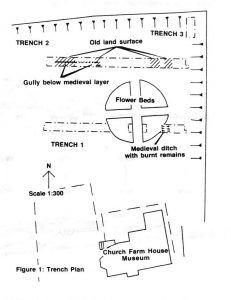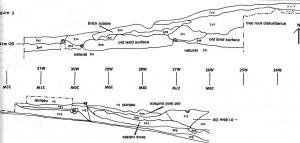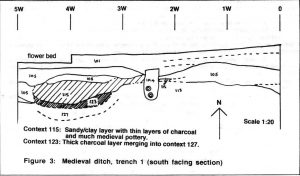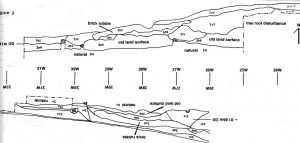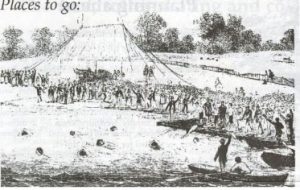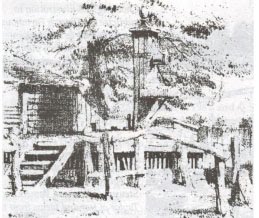ISSUE NO. 281 – AUGUST 1994 Edited by Anne Lawson
DIARY
Tuesday – Saturday 9-13 August – ISLE OF MAN. Our group is full up and we have a waiting list, but further names can be added if you wish: ring 081-203 0950.
Saturday 3 September – OUTING TO NEW BUTSER SITE, OLD WINCHESTER HILL AND ALTON with Bill Bass and Vikki O’Connor (details and application form enclosed).
Tuesday 4 October – EXCAVATING IN EGYPT Lecture by Patricia Spencer Saturday 8 October MINIMART
Saturday 29 October – City Walk with Mary O’Connell
Tuesday 1 November – The Hoxne Hoard and Others: Late Treasures from Britain. Lecture by Dr Catherine Johns.
Dorothy Newbury has organised our lectures for the past 15 years or so and the time has come when the job must be passed on to “Someone Else”. This is something that can be done entirely by phone or letter, and we already have a few names of possible speakers in hand. Will volunteers please phone 203 0950.
LEWIS CARROLL IN WONDERLAND
Church Farmhouse Museum, Greyhound Hill, NW4 (203 0130) 25 July – 25 October 1994
The exhibition celebrates the 25th anniversary of the Lewis Carroll Society, which was founded by Ellis Hillman – now fortuitously Mayor of Barnet. It is based on one of the three main private collections
of Carroll material, and includes early editions of Alice in Wonderland and Through the Looking Glass, as well as examples of his other works; original photographs and letters; sequels to, and -parodies of, his children’s books; translations; and a wide selection of material from the Carroll ‘industry’ – from sweets to sheet music.
A programme of associated events will be held at the Museum and at branch libraries in the Borough.
Mon – Thurs 10 am – 5 pm. Friday – closed. .Saturday 10 am – 1 om, 2 pm – 5.30 pm. Sunday 2 pm – 5.30 pm. Admission free.
I write to thank Roy Walker for his thorough and thoughtful review of my recent book on Whetstone and Finchley. I am pleased that he spotted one of the two mistakes in the final version.
His article raises the question of audience – just who is the book aimed at? I decided a reading age of about 81/2 and an attention span of about 20 seconds or should I have said “approximately a third of a minute?”
I found two aspects of writing the book particularly interesting, one is which words actually to use and the other is how to spell them. Thank you, Roy. JOHN HEATHFIELD
THAT SAXON PIN AGAIN Ted Sammes
In connection with the Maidenhead Heritage Centre, two of us on its Committee went on a “museum crawl” to see how others were managing in the Oxford/Bucks area.
In the Abingdon Museum T. espied a Saxon double-headed pin with in turned spiral head. This one is slightly smaller than the one from Church Terrace, Hendon, found in 1972/73. It had come from Saxon layers in Abingdon – I am trying to get more details.
A drawing of Hendon’s pin can be seen in “Pinning Down the Past”, page 10, published by HADAS in 1986.
From Christopher Eve, the Local History Librarian
NAN CLARK – REVEALING THE PAST OF A GHOSTLY LOCAL LEGEND
.Many of the residents of Hendon and Hill know of the legend of
Nan Clark – that her ghost still appears at midnight beneath a full moon to haunt the lane on Highwood Hill which bears her name. Some of the locals at the “Rising Sun” have even seen her appear in the old 17th century Pub. During the last war a sentry at Moat Mount called out the guard because he saw a woman walking down the lane and across the fields. The guard surrounded the area and moved in, but found nothing. Then in 1950, a group of ghosthunters led a midnight vigil at the lane in the hope of seeing the ghost. The story, reported in the “Hendon & Finchley Times” of November 24, 1950 said that no contact was made; although a Mrs. Beales, not to be outdone reported a “strong contact” and felt that “there was definitely something there.”
So who was Nan (or Ann Clark? Parish records are scanty, but it appears that she was a licensee of “The Three Crowns Inn” which once stood at the corner of Nan Clark’s Lane. In 1698 she was granted a renewal of her victualler’s licence and, in 1700, there is a record of her petition to licence an alehouse.
At that time all ?arishioners who could ?ay were assessed for contributions to the parish poor rate; records of which were kept by the local churchwardens. Careful study of these accounts reveals the following entries:
1703 –
paid
13 months for Clark’s two children,
£10
8s.
1704 –
paid
8 months for Clark’s two children,
£ 6
8s.
gave
with one Clark’s girls apprentice,
£ 5
1705 –
expended in having Eliz. Clark to London, paid for nursing Mary Clark 39 weeks,
£ 3
7s. 18s.
1706 –
paid
for ,putting Mary Clark apprentice,
£ 5
5s.
From these entries it appears that Nan Clark was the mother of two daughters, Elizabeth and Mary, who waseen 1703 and 1706 were receiving support from t1:-Elizabethhere is one conclusion which we might draw -that their Mother was dead by 1703, yet parish records state that she was not buried until July 7, 1708. Where was she during those five missing years:
further back, the parish records state that Vary Clark was baptised at St Mary’s, Hendon on July 1 1694. E1izabeth was baptised at St Andrew’s, Totteridge two years earlier. Mary is described as the daughter of Edward Clark, so it is probably that he is Nan’s husband. In addition, the records state that in 1685 Edward Clark, in being assessed for the poor rate, is described as a victualler, a strong link with Nan. Edward was the younger son of William Clark,a wealthy and respected member of the community and parish churchwarden. He died in 1696, his estate passing to the elder son, also called William. In 1690 the records show that there was a petition for the suppression of Edward’s licence as victualler. Could it be for some reason, that he was resented by the community and perhaps his father, because he had married Nan?
One last entry of interest is to be found in the records of the Sessions of the Peace at the Old Bailey. The case concerned was heard on October 2, 1702 and the names at the beginning of the entry include Elizabeth, Mary and William Clark. We can conclude that this was the hearing at which the two children were out into care. William Clark is probably referred to here as their guardian – he was, after all, their uncle.
What became of Edward and Nan Clark? Why is her spirit not at rest but still walks the lanes of Mill Hill Village where she once lived all those centuries ago?
SPECKLED HEN, THE MAYOR OF OCK STREET & POOH STICKS ROY WALKER
Last year when we were excavating at Church Farm, the Greyhound Inn held a beer festival which introduced one or two of us to a strong beer called “Old Speckled Hen” which was brewed at Abingdon. So, when the outing to Abingdon and Dorchester-on-Thames was announced there was an immediate vote in our household in favour of going. The two Mickys, Cohen and Watkins, must have had the same interest because the morning started in Abingdon with refreshments in an old brewery, albeit one belonging to the Benedictine Abbey of St Mary, originally founded in AD 670 but rebuilt in the 12th century. All that now remains after 1538 is the Checker used as the Abbey’s accounting centre, the Checker Hall which has now been converted into an Elizabethan theatre and the Long Gallery with evidence of partitioning for use as accommodation in the late 15th century. These first floor rooms which had once been used as a brewery were above a lower hall and undercroft. The Main Gateway has also survived. Our introduction to the archaeology of Abingdon came from Tim Allen of the local unit who warned us that all the excavated remains had now been built over, the work of his unit having been very much of a rescue nature in advance of redevelopment. All archaeological periods are represented from the Iron Age onwards.
We were only able to catch a glimpse of the beauty of this town with its medieval houses as we progressed between the churches of St Nicholas and St Helens ably guided by members of the local archaeological society. The Mayor of Ock Street was being elected that day – an unofficial office dating back to 1700. Morris Men were dancing outside the public houses in Ock Street!
After lunch, the coach took us towards Dorchester-on-Thames (hereinafter called Dorchester) through “Three Men in a Boat” country. We stopped at Wittenham Clumps, two beech hills known locally as Mother Dunch’s Buttocks. David Miles, Director of the Oxford Archaeological Unit greeted us at the Clumps where he set the prehistoric scene for us atop one of the hills. We were at a spot which dominated the route to London, at the junction of the Thames Valley and the Vale of the White Horse. There had been much excavation on the valley floor where lakes now filled the gravel extraction pits. Gravel extraction and the Dorchester bypass had contributed both to the need for urgent rescue archaeology as well as to the destruction of much of this area’s Neolithic heritage. To the north of us was the Big Rings Henge, discovered in 1930, adjacent to the Dorchester Cursus; further north still was Mount Farm with Bronze Age burials and evidence of trackways within an extensive field system; at Bishop’s Court, north west of Dorchester were found Anglo Saxon inhumations as well as a two-headed late Saxon bronze ornament adopted as the logo for the Oxford Archaeological Unit below.

We left for the neighbouring buttock – Castle Hill – a univallate hillfort which has yet to be excavated although field walking has revealed Iron Age pottery. An Iron Age settlement however was excavated just to the south of the fort. Dorchester importantly lay on the boundary of three tribal groups, the Dobunni, Catuvellauni and the Atrebates. We were shown our next destination, the late Iron Age oppidum, Dyke Hills, lying one mile away across the Thames. This would be reached by a leisurely stroll through the woods, across the bridge where Christopher Robin played Pooh Sticks, and over several stiles. The weather was ideal for the walk, the stiles were easily crossed and several pooh sticks were purchased at the bridge (proceeds to the RNLI).
We rested at the oppidum while David outlined its history and the problem of obtaining permission to investigate the area further. The enclosure covers 114 acres with a double bank to the north and east, the south and west boundaries have vanished but are traceable. Cropmarks show the interior to contain circular houses aligned to internal roads. As the River Thames lies to the south and the River Thame to the west, it is likely that this was a traditional river crossing site. Even today, as then, the Thames often flows between the ramparts creating a moat. Anglo Saxon burials excavated within the oppidum area had early Saxon grave goods including a bronze buckle of c5th century similar to those found in continental military contexts. Other female burials also had brooches of north German origin, a sign that the Dorchester Roman garrison by AD 430 – 450 had many German settlers, perhaps foederati. Signs of 5th century settlement in and around the town of Dorchester have been recorded. Earlier excavation by Colonel Lane-Fox (later General Pitt-Rivers) had highlighted the familiar problem of cultivation destroying archaeology which led to the passing of Ancient Monuments legislation. We entered Dorchester where very little of its Roman history survives. It was probably a Roman customs post controlling river traffic to London as evidenced by a now-lost altar found in 1731, set up by Marcus Varius Severus a 2nd/3rd century “beneficiarius consularis”, a toll collector.
In AD 635, according to Bede, Bishop Birinus was sent to Britain to convert the natives. King Oswald of Northumbria visited Cynegils, King of the Gewisse (West Saxons) in order to marry his daughter. Birinus converted Cynegils and was granted land in Dorchester to establish his cathedral church. He died and was buried in Dorchester but his relics were later moved to Winchester. A shrine was erected in Dorchester Abbey in the 14th century but was destroyed in 1536. We visited the Abbey church conveniently situated next to the tea rooms. Unique to the church is a Tree of Jesse window with sculpted tracery forming the trunk and branches of the tree and the figures of Christ, David etc provided within the 14th century stained glass window. Of interest was the lead font of c1170 and a memorial of a knight, recumbent but drawing his sword. Dating from c1280, it is claimed that this dynamic sculpture influenced Henry Moore. The town itself provided many delights with its collection of medieval buildings, timber framed from local timber supplies, now depleted. The George Hotel, dating from the late 15th century, has a galleried range at the rear; the White Hart replaced the wattle and daub infill between its windows with brick nogging in 1691; the Bull Inn with its jettied upper storey. We started the outing at a medieval brewery and finished on a very similar theme!
Many thanks to Micky Cohen and Micky Watkins for such a delightful day which managed to combine many periods of archaeology, good weather, an excellent stroll through the English countryside and the perfect guides for the sites. The “Old Speckled Hen” was a bonus!
EXCAVATION OF THE WHITE HORSE AND HILL FORT AT UFFINGTON
HADAS members who went on the Abingdon/Dorchester trip will remember David Miles, Head of the Oxford Archaeological Unit,who conducted us from Wittenham Clumps to Dorchester, and gave us an excellent talk on the iron age sites. He suggested that some of our members would enjoy visting the Unit’s excavation of the White Horse and Hill Fort at Uffington. Trenches will be open between 14th and 20th August, and the archaeologists will welcome visitors on Sunday as well as during the week. This is an excellent opportunity to visit a site of great importance in a beautful part of England.
MEMBERS’ NEWS
MISS SHELDON, a member affectionately known as Shemmie, left London a few years ago to live in Yorkshire. She is still in touch with Renata Feldmeier, and although she is now in her eighties, she says she is still making peg-bags and oven cloths for charity as well as the mending jobs for which she was so well known in the Suburb. She says how much she always enjoyed the HADAS activities and wishes to be remembered to us all.
Outing to Richborough Castle and Archbishop’s Palace, Maidstone
After a late start and unfortunately without Tessa who was not well enough to join us, we set off on the M25 and over the Queen Elizabeth II Bridge to catch our first sight of distinctive Kentish oasthouses.
Our first stop was at The Friars, Aylesford, a Carmelite retreat and conference centre which provided welcome refreshment in its restored tithe barn.
On our way to Richborough we stopped to see Kit’s Coty (misnamed by the locals who had mistaken it for the remains of a house). The burial chamber is sited alongside Kent County Council’s Centenary Walk in a field full of beautiful poppies with wide views out to the surrounding chalk downland. The stones formed a burial chamber at the eastern end of a Neolithic long barrow circa 2000 B.C. which was originally an earth mound some 180 feet long. Now the stones are unfortunately only covered with ancient and modern graffiti.
We then made our way to Richborough through the orchards of Kent, past Canterbury’s city walls, through the very pretty village of Wingham, past “Pick Your Own” in full swing and on to the flat salt marshes at Richborough. There we were met by Dr. Tom Blagg who gave us a very interesting talk and guided tour of Richborough Castle.
Richborough Castle is a very difficult site to take in all at once because of the complicated chronology. There was some evidence of use during the Iron Age and then in A.D.43 it was the site of the Claudian invasion of Britain and became a supply base from A.D.43 to A.D.85. It thereafter became a Saxon shore fort and eventually was used by the Saxons until falling into disuse with many of the dressing stones of the walls carted away by locals over the centuries to incorporate in their own buildings.
The site was chosen by the Romans to launch their invasion of Britain because it was easily reached from the coast of France and could cope with the landing of the invasion fleet of some 500-600 ships. At that time the site had a natural defence and water route in the water channel (since silted up) adjoining it which flowed eventually into the Medway.
What now remains on the site are part of the walls, the interior and exterior mounds and ditches, the foundations of the monument, the remains of a bath house and the remains of a Saxon church including its font. There is very little evidence of Roman buildings within the site which leads archaeologists to conclude that any buildings were made of wood and/or the site was used as a temporary camp and the soldiers bivouacked under canvas.
The monument was in the form of a triumphal arch and could possibly have been erected to commemorate the invasion of Britain. The monument was indeed of monumental size. The foundation pit measured some 38m by 24.5m and was some 10m deep. It was the only Roman building in Britain known to have been dressed with Carrara marble (the same as that used by Michelangelo).
It is believed that the site was used by the Romans up until the beginning of the fifth century (evidenced by the fact that amongst the very many coins found on the site were coins issued under Theodosius).
The coach was strangely quiet on the way to the Archbishop’s Palace in Maidstone with nearly all the group fast asleep.
The medieval Palace was built by Bishop Courtney when Maidstone was a five day journey from London. The medieval cattle market adjoins the Palace and is at the present time still used both as a cattle and general market.
We were shown round the Sir Garrard Tyrwhit Drake Carriage Museum in what were the stable buildings by our guide, Daphne Bailey, who gave us a very entertaining tour. There were carriages of every size and shape and the passengers were catered for from birth to death for the carriages included both a christening sedan and a hearse.
Hearing the actual history of each of the carriages certainly added to our enjoyment. And to add an even more personal touch, the museum attendant was descended from the man who made the decorative tassels of the carriage interiors. This tassel maker made a very good marriage to a princess of the Russian royal family. of her family of three daughters and three sons, only her daughters survived adulthood, her three sons having died young of the royal disease of haemophilia.
Our guide, Florence Lee, then conducted us on a whistle atop tour of the Palace itself which is now a combination of a very well mot out and interesting museum and function rooms. As a wedding party was going an in the function rooms our tour of the Palace was necessarily curtailed and it was a moot point as to whether Hadas got in the way of the wedding party or vice versa!
After a very good tea provided by two stalwart ladies All Saints Church we were given a tour of the church itself by a church warden. The church is the parish church of Maidstone and was founded as a collegiate church in 1395 by Archbishop Courtenay whose tomb is in the Church. Or is it – he is apparently also buried in Canterbury Cathedral. What a shame it was all too long ago for genetic fingerprinting to give us the definitive answer.
The church also contains a memorial to the family of George Washington. The coat of arms of the family depicted on the memorial includes stars and stripes and it is said that this is where the stars and stripes of the American flag originated.
Our tour of the church completed a very full and enjoyable day (as we have come to expect with Hadas outings). our thanks to Sheila and Tessa for organising a lovely outing and to Sheila for so ably coping on her own. Our commiserations to Tessa for missing a very nice day and we hope she is soon well again.
IRENE GAVORRE
HADAS member Jack Goldenfeld reminds us that he is running his course “Glimpses of the oast – an Introduction to Archaeology” for two centres this year: West Herts College, at Rickmansworth, and Stanmore College, Stanmore. The course is designed to describe and explain the science of archaeology, to develop.) an awareness of the past and the recognition of its effects on the world today. As well as dealing with
archaeological theory, the course study archaeological site
examples of all periods and from all five continents. T t consists of ten evening meetings per term, commencing 21st September for West
Herts and 29th September for Stanmore.
Details from Jack at n923 285225 or West Hertsat 0923 255533 or Stanmore at 081-954 9481.
PLANNING APPLICATIONS IN THE NORTHERN AREA BILL BASS
The following sites have been noted in the development applications list and may be of archaeological interest:
75 High Street. Barnet. English Heritage have now recommended an archaeological watching brief at this site.
38 Barnet Gate Lane, Arkley. The proposed demolition of an existing house, and the building of a four bedroom detached house and double garage here, has led English
Heritage to ask for further consideration of the planning application, following a preliminary archaeological appraisal of the site. “Barnet Gate was the site of a
manorial court in the medieval period, and the settlement there may have originated in the Anglo-Saxon period” (HADAS: A Place in Time p59).

